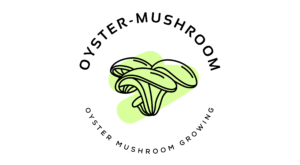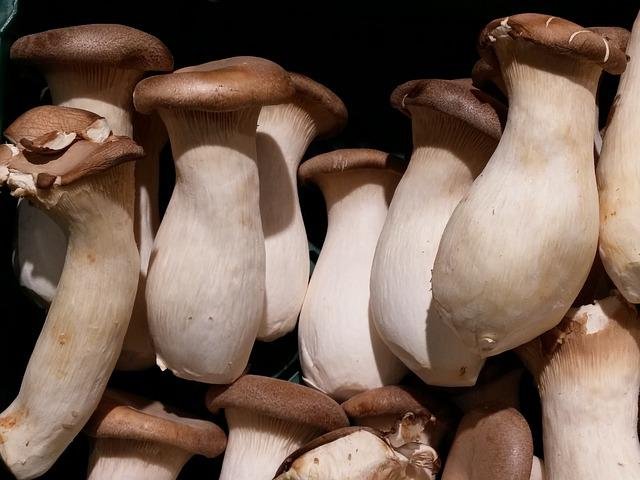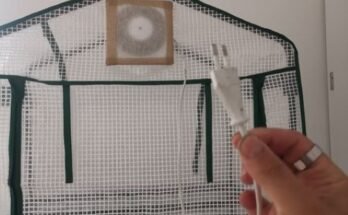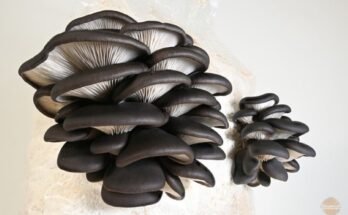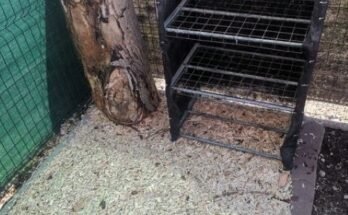Oyster mushrooms are one of the most popular edible mushrooms. They are available in a variety of shapes, sizes, and colors. One of them is the King oyster mushroom (Pleurotus eryngii) which is also known as King trumpet mushroom. It is the biggest mushroom in the oyster mushroom family. King oyster native to the Mediterranean region, North Africa, and the Middle East, tastes like fresh scallops and has a great culinary value.
The name of ‘King oyster’ is given due to its stately appearance and culinary flexibility. It is used in several dishes particularly in French, Japanese, Korean and Chinese cuisines. It is often used as a flavorful ingredient in soups, pasta, pizza, etc., and gives a savory and umami flavor to every dish with a meaty texture.
Nutritional value
King oyster mushrooms are rich in nutrients. They contain carbohydrates, fats and proteins. The protein value of king oyster mushrooms is comparable to chicken, mutton, and beef. They also contain sodium, niacin, fibers, sugars, and a few other vitamins and minerals such as riboflavin, phosphorus, manganese, copper, iron, potassium, pantothenic acid, and magnesium. Due to their rich nutritional value, king oyster mushrooms are very beneficial for health.
King oyster mushrooms provide antioxidants that promote the immune system, and heart health, control blood sugar levels and are anti-inflammatory in nature.
Features of King oyster mushroom
King oyster is an enlarged tender stem that does not produce a shelf like formation like other oyster mushroom varieties. It has a well-defined white stipe with a round brown cap and wavy looking gills on the underside. The cap of the king oyster unrolls with maturity, becomes flat, and eventually uncurled.
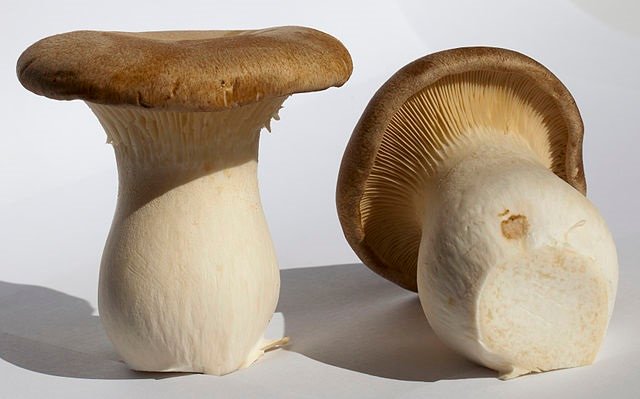
If king oyster mushrooms are grown indoors under low light conditions and minimal availability of fresh air, they will produce a fat tall stem with a small cap. If they are grown under a lot of fresh air and more light, they will produce small stems and large caps.
How to grow King oyster mushrooms at home?
King oyster mushrooms can be easily grown at home. Once you decide to grow king oyster mushrooms at home you will need some material to get started. You can also buy a king oyster mushroom grow kit that will contain all the supplies and a complete guide on how to grow king oyster mushrooms.
Here I will share a step by step guide on how to grow king oyster mushrooms at home.
Step 1. Purchase king oyster mushroom spawn
The first thing you must consider while growing king oyster mushrooms is to gather your supplies. You will need a fresh good quality king oyster spawn. Fresh spawn will give a better spawn run and yield. On the other hand, the old spawn will show poor colonization of the substrate. Always purchase fresh spawn from a reputable dealer. You can also purchase spawn from online sources. Make sure to buy spawn according to your need and use it fresh. Check our Article How to make Oyster Mushroom Spawn.
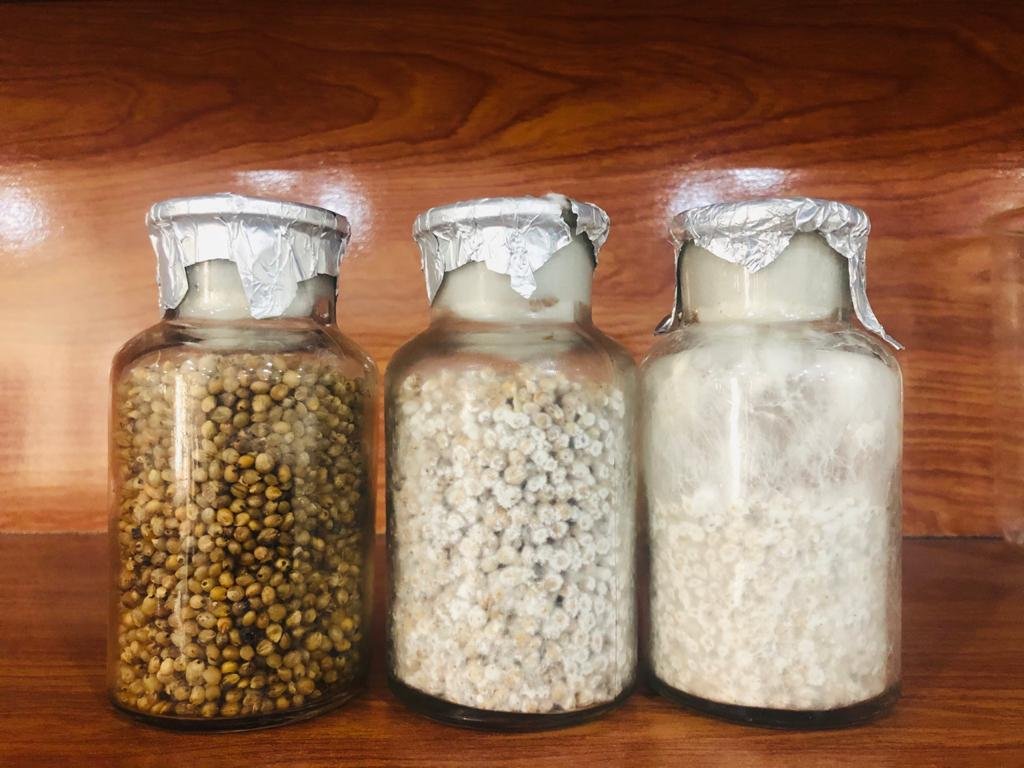
For beginners, it is recommended to buy a king oyster mushroom growing kit online. It will save you the time and effort of purchasing everything separately. The kit contains all the basic information for growing king oysters.
Step 2. Prepare substrate and grow bags
A substrate is a basic medium on which a mushroom grows. It is a source of food for mushroom mycelium that provides nutrients to support the growth and colonization of mushroom mycelium. In the wild, king oyster mushrooms usually grow on dead or dying woody tissues. King oyster mushrooms growing on hardwood or a substrate that is mixed with hardwood are very delicious. It would be great if you can add hardwood to a substrate mix it will improve the yield and taste.
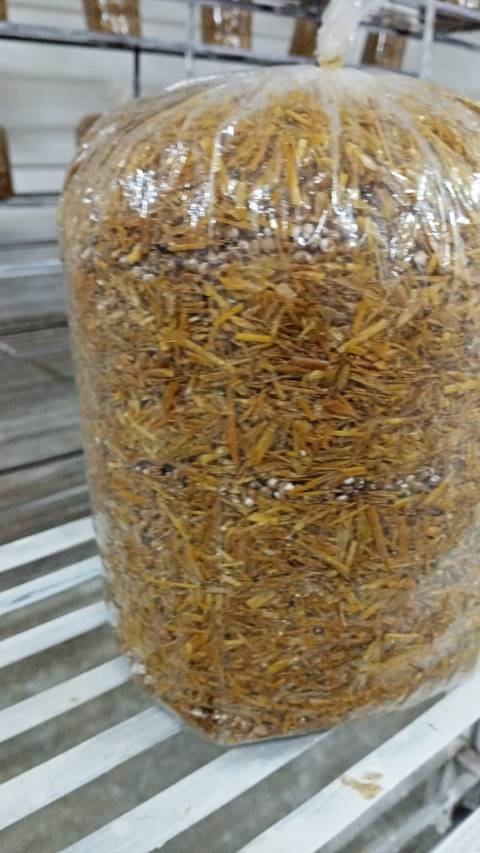
Several substrates can be used for growing king oysters such as wheat or rice straw, paper dust, sawdust, sugarcane bagasse, cotton waste, coffee grounds, etc. You can mix hardwood in any of these substrates for good yield. However, if hardwood is not available you can use these substrates alone. Always choose a substrate that is easily available and inexpensive. Moreover, the substrate must provide plenty of nutrients to promote a high yield of king oysters.
You will also need grow bags to grow mushrooms at home. You can purchase good quality mushroom grow bags from the market. If you have bought a mushroom growing kit, then it will already contain grow bags.
Step 3. Preparation of the substrate
Once you have all the supplies in your hand the first thing that you should do is to prepare the substrate. Substrate preparation is the most important step that must be done properly. Pasteurization of the substrate is very important to remove the unwanted microbe growth. The unwanted microbes compete with the desired king oyster mushroom mycelium for food and space and ultimately reduce the mycelial colonization and yield.
Moisten the substrate and fill it in grow bags. To pasteurize the substrate put the grow bags in a large container of hot water at 60 to 80 degrees for 1 hour. High temperature is effective to kill all unwanted microorganisms. You can also use a hydrated lime treated water bath to soak the substrate for 1 day. Both these methods are quite effective for the pasteurization of substrate.
You can also use large autoclaves that use steam to sterilize the substrate. But autoclaves can be expensive at the home level.
Step 4. King Oyster mushroom Spawning
Once the substrate is pasteurized add the spawn of king oyster to the bags and this process is known as spawning or inoculation. It is recommended to add 20 to 30 grams of spawn in 1 kg substrate for obtaining a good yield. Put a layer of the spawn on the top surface of the substrate and close the bags tightly with a clip or rubber band. Make several tiny holes around the bag to allow for air exchange. Mushroom mycelium requires proper aeration for mycelial colonization and the production of fruiting bodies.
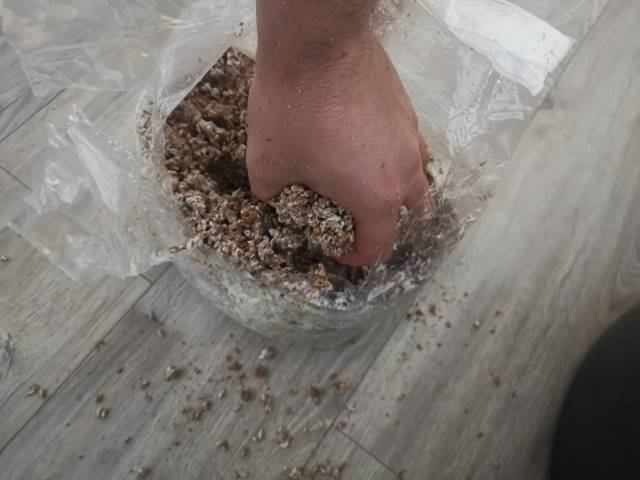
Step 5. Incubation
Keep the mushroom grow bags in a dark place of your home. Maintain the temperature of the grow room between 68- to -77-degree Fahrenheit (20 to 25 degrees Celsius). If the temperature of the room goes below or above this range, it can cause a reduction in colonization and development of the mushroom mycelium. The humidity should be high in the grow rooms preferably above 70 %. With warm temperature, high moisture, good aeration, and proper nutrition the mushrooms will start growing and colonizing the grow bags rapidly.
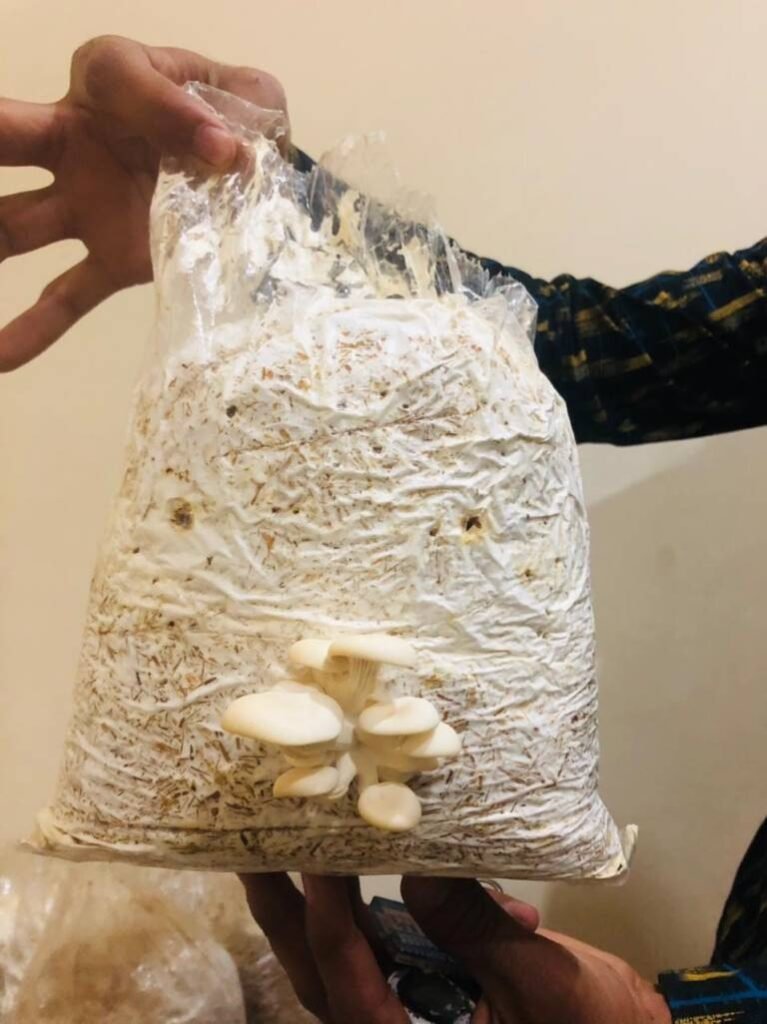
Keep monitoring and check the bags carefully for any contamination or abnormal growth. If any of the grow bags are infected with other fungi or bacteria discard them immediately to prevent the contamination from spreading to other bags.
Step 6: Casing
A casing layer is applied on the fully colonized substrate to increase humidity, improve the quality of fruiting bodies, and to improve the yield. A casing layer is optional while growing oyster mushrooms. There can be a slight risk of contamination while applying a casing layer.
However, king oysters are often grown with a casing layer on the top. A casing layer is a mix of 50 % vermiculite, 50 % coco coir, and 1 % hydrated lime. This mixture is applied to the surface of the substrate fully colonized with mushroom mycelium.
Step 7: Provide optimum conditions for the development of fruiting bodies
When the mushroom substrate is fully colonized with mushroom mycelium you must provide optimal growing conditions to promote the fruiting and a bountiful harvest.
- Spray the substrate twice a day with water to maintain high humidity in the grow rooms. Mushrooms require high moisture for the formation of fruiting bodies and mycelium colonization.
- Mushrooms generally do not require direct light to grow, however, exposure to indirect light can promote the formation of fruiting bodies.
- Temperature fluctuations can significantly affect mycelial colonization and fruiting body formation. The temperature of the grow room must be warm enough to support the development of oyster mushrooms and to promote a good yield.
- If you ensure the supply of optimal humidity and temperature the mushroom mycelium will colonize rapidly and start pinning very soon.
Step 8: Harvesting
This is the most awaited stage in mushroom growing journey. When to harvest king oysters depends on the grower’s choice. Small and young king oyster mushrooms will have a better texture and flavor, but the yield will be low. To harvest oyster mushrooms, you can simply twist the bunch of mushrooms from the base, or you can use a clean sharp knife or scissor to cut the king oyster from the base. Be careful don’t damage the top of the block to obtain the subsequent flushes successfully. Leave those mushrooms that are just sprouted and let them grow fully.
The king oyster mushrooms should be ideally harvested within 2 to 3 days. If you delay harvesting the oyster mushrooms will dry out and will not be suitable for consumption. Once the first flush of king oyster mushrooms is harvested the next flush of mushrooms will be ready for harvest and it will take 7 to 10 days to complete a cropping cycle.
There are a few indications that the king oyster mushrooms are ready for harvest.
1. Look at the cap of the king oyster mushrooms if it starts flattening from the edges of the cap then it is ready for harvest.
2. The edges of caps and the gills will start turning slightly dark.
3. The king oyster mushrooms will start to harden and dry out.
It is recommended to harvest king oyster mushrooms timely otherwise they will overgrow and get spoiled.
Step 9: Preservation and storage
It is better to consume king oyster mushrooms fresh. King oysters do not have a long shelf life at room temperature they will go bad within a couple of days. You can store them in a refrigerator for a week. However, if you have a surplus supply of oyster mushrooms then you can try mushroom preservation methods for long time storage. King oyster mushrooms can be dried or stored in a brine solution for a long time.
How to maintain conducive growing conditions for growing king oyster mushrooms at home?
It is important to maintain optimal growing conditions for king oysters to promote their yield. I will share a few useful tips on how you can maintain ideal growing conditions for king oyster mushrooms at home.
- Locate a clean and aerated space at your home.
- To maintain high humidity, you can install a humidifier or spray water in the grow room several times a day. Also, make sure the exhaust fan is also fitted in the grow room.
- To maintain temperature, you can install heater or air conditioners depending upon the prevailing temperature.
- For substrate pasteurization, it is better to buy a large drum fitted on a burner.
- Artificial grow lights must be installed in the grow rooms to provide light
What are the ideal fruiting conditions required for king oyster mushrooms?
Spawn run: 10 to 25 degrees Celsius is required for the spawn run. King oyster mushroom mycelium takes 10 to 14 days for full colonization of the substrate.
Fruiting: 7 to 20 degrees Celsius is required for fruiting body formation. Fruit development takes place in 4 to 8 days.
Humidity: Above 80 % humidity is required.
Problems of king oysters growing
King oysters are resilient in nature that can resist contaminants. However, they are susceptible to blotch (Blotch is the appearance of large irregular spots on the surface of mushrooms). Blotch is a bacterial infection that is caused by high humidity. Bacteria require moisture for their growth and division therefore high humidity increases the growth and multiplication of bacteria. To reduce the risk of blotch, reduce the humidity and ensure that water droplets do not stay on the fruiting body for too long. Make sure the grow room has proper ventilation.
Health Benefits of King Oysters
King oyster mushrooms have amazing health and medicinal benefits.
- It boosts the immune system
- It improves the strength
- Anticancer properties (King oysters contain anti-tumor polysaccharides)
- Antimicrobial properties (Help to fight against microbial infections)
- Antiviral (It protects against viral infections)
- King oysters contain high levels of Vitamin D and A
- They are rich in protein
- They have zero cholesterol
Bottom Line
Home grown king oyster mushrooms are rich in nutrients and delicious in taste. They must be included in the diet to reap their amazing health and medicinal benefits. King oyster mushrooms are easy to grow at home and do not require a lot of investment. You can start growing king oysters with minimal investment at any clean and airy place available in your home.
Now you know all the steps for growing king oyster mushrooms at home. Give it a try and share some fresh king oyster mushrooms with your friends and family.
